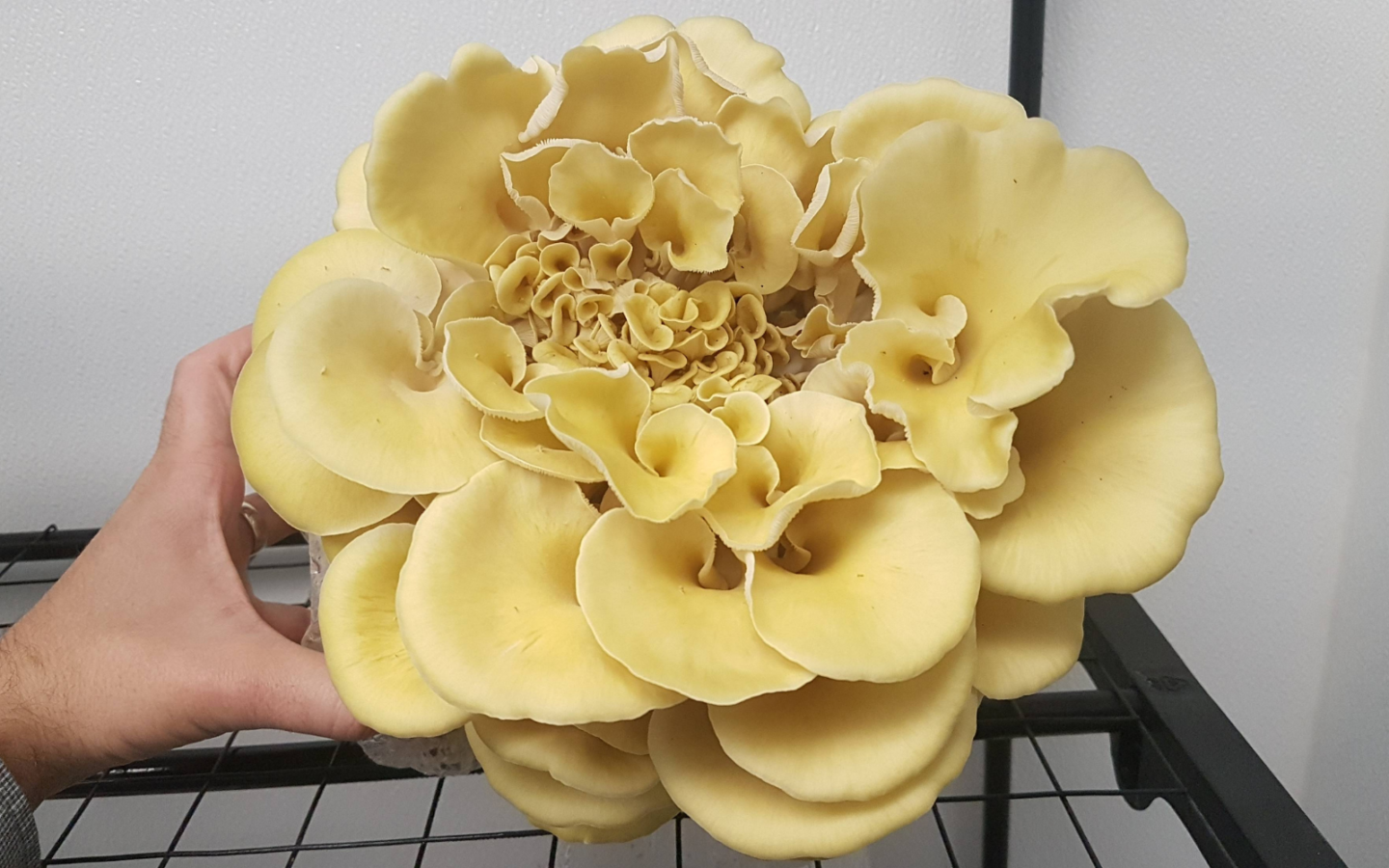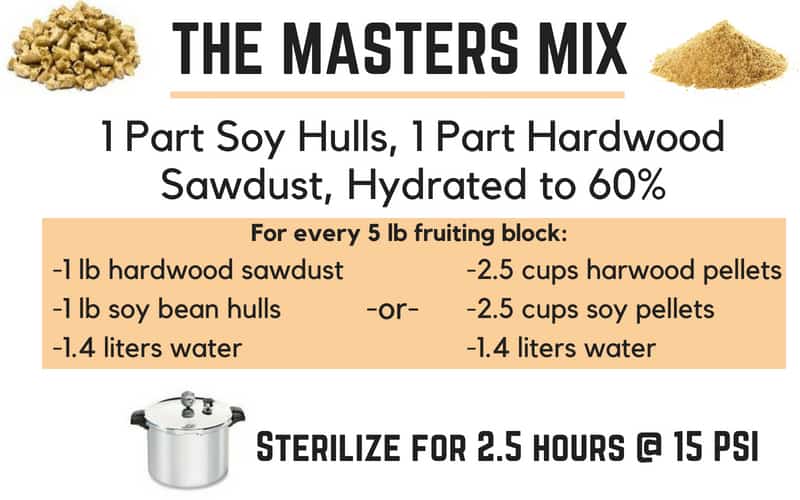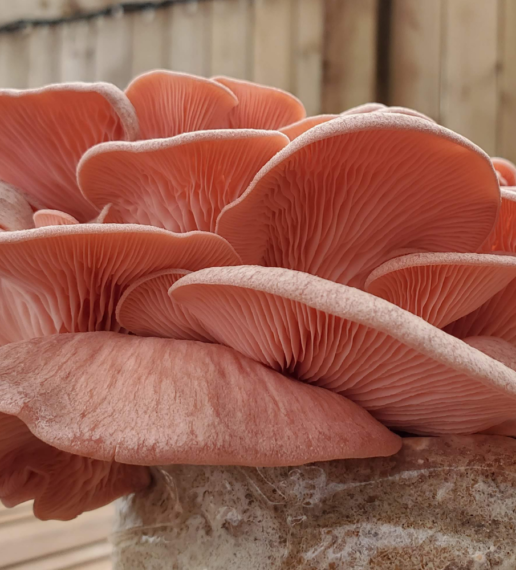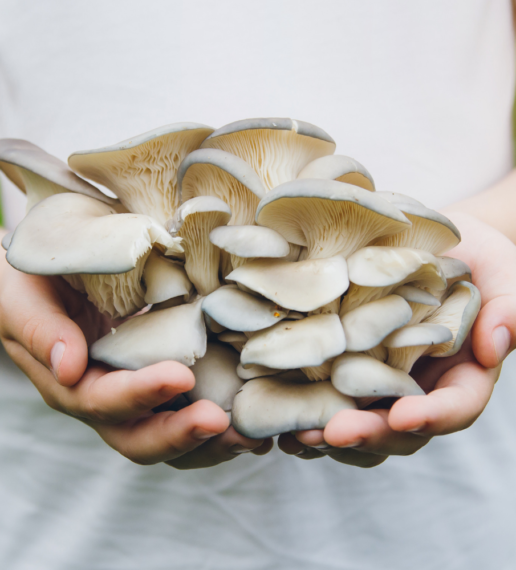Growing Blog
Growing Mushrooms on Soy Hulls (The Masters Mix)

One of my favorite things about being a dedicated mushroom grower is that I’m constantly learning new things. As soon as I think I have it all figured out, I’ll try something new that changes everything.
In fact, the more I learn, the more I realize that there is so much more to learn!
A perfect example of this occurred just recently, when I picked the most gigantic flush of Blue Oysters I’ve ever seen off of a 5 lb fruiting block. (almost 2 lbs!)
The thing is- this particular fruiting block wasn’t made with the standard fruiting block recipe of sawdust amended with bran. Instead, this unbelievable bounty was harvested from a 50:50 mix of hardwood sawdust and soy hulls- known by many as the “masters mix”.
As far as I know, the master behind this substrate recipe is T.R. Davis from Earth Angel Mushrooms. I first heard of it while browsing some of his videos on his YouTube, where he describes this beautifully uncomplicated substrate recipe while standing in front of some pretty impressive looking oyster blocks.
I couldn’t wait to give it a try!

THE MASTERS MIX
The masters mix is pretty straight forward:
“Combine 1 part hardwood sawdust with 1 part soy hulls, hydrate to 60%, and sterilize at 15 PSI for 2.5 hours.”
It is simply A 50/50 mix of soy bean hulls and hardwood sawdust hydrated to perfection!
To break it down even more, for every 5 lb fruiting block, you need:
- 1 lb sawdust
- 1 lb soy bean hulls
- about 3 lbs (1.4 liters) water
Many hobby growers like to use hardwood fuel pellets, and pelletized soy hulls instead of bulk. In that case, in order to get the perfect mix, you’ll need:
- 2.5 cups Hardwood Fuel Pellets
- 2.5 Cups Pelletized Soy Hulls
- 1.4 Liters of water
Just mix up the ingredients and sterilize! The hardwood pellets break apart really easy, but Soy Hulls need a little more encouragement-, so be sure to soak them overnight so they are easier to mix.

Why Grow Mushrooms On Soy Hulls?
So what are soy hulls and why are they so effective?
Oyster mushrooms are known to grow on just about anything… coffee grounds, sawdust, banana leaves, cotton seed hulls, and many other agricultural waste products… they all make reasonable substrates.
But some substrates are bound to produce faster growth and higher yields, and I gotta say that for Oysters, I have never seen something so effective in producing huge yields as the Master’s Mix.
Soy Hulls are just the exterior skin of Soy Beans, and are essentially a waste product of soybean farming.
For whatever reason, these soy hulls – when mixed with sawdust – have just the right nutritional composition for explosive fruiting, huge yields, and nice big fruits. It also seems to produce large and dense clusters, with endless folds of oyster mushrooms just clamoring all over each other to burst out of the bag.
You can play around with different ratios but most growers note that a 50-50 mix is ideal. Any more than 50% Soy Hulls, and your mix will be too nutritionally dense, and you will have a higher risk of contamination, or deformed mushrooms. Using less than 50% will diminish expected yield due to insufficient nutrition.
Pelletized Soy Hulls
Unless you live in a rural area and have direct access to a soy farm, you are most likely to find soy hulls in pelletized form, commonly sold as a nutritional supplement in horse feed. I can’t confirm what the horses think, but I can tell you that mushrooms sure love them!
Pelletized Soy Hulls are relatively cheap, and should be easy to find at any agricultural feed store. You might even be able to find them online.
These rock-hard pellets are not as easy to break up as hardwood fuel pellets- which naturally break apart as soon as you add water- so you are best off to soak them in water overnight, which makes them easy to mix with sawdust.
The soy is quite sticky and gooey, so be prepared to make a bit of a mess.

Making Soy Hull Fruiting Blocks
Using the recipe described above, follow these steps to grow mushrooms on soy hulls with awesome results every time:
STEP 1: Soak the Soy Hulls
Soak the hulls in the appropriate amount of water, which is about 700ml for every 2.5 cups of pelletized hulls. It’s best to soak the hulls overnight so that they get a chance to break up. You can also use boiling water which will allow the soy hulls to break up a lot faster, although you’ll still need to loosen them up with your fingers if you want to use them right away.
STEP 2: Hydrate the Fuel Pellets
Add 700ml of water to the fuel pellets until they are evenly broken up. Using hot water can speed this process up significantly. If you use cold water, just use your fingers to break up all the pellets into a nice even sawdust.
STEP 3: Mix and Sterilize
Mix the hydrated soy pellets and hardwood sawdust thoroughly and pack into a large autoclavable mushroom grow bag. Fold over the top of the bag and pressure sterilize at 15PSI for 2.5 hours. I am sure that you can get away with a shorter sterilization time, but I have not experimented with this too much. I like to play it safe, and 2.5 hours will be sure to kill whatever contamination might be lurking in your substrate.
STEP 4: Inoculate, Colonize and Fruit
Inoculate each 5 lb block with around 1 quart of your favorite oyster mushroom spawn. I have tried both Blue Oysters and Yellow Oysters on this mix and they both performed fantastically. Once colonized, you can fruit by cutting off the entire top of the bag, or by cutting a slit across the side of the block and laying it on its side.
Sometimes the block will start to pin heavily on top of the block before you are ready to fruit it. If this is the case, then simply cutting off the top of the bag is the way to go.

Downsides Of The Masters Mix
There are a few downsides to the Masters Mix, even though overall the pros definitely outweigh the cons.
SLOWER COLONIZATION
Soy hulls and sawdust definitely seem to colonize a lot more slowly than the typical sawdust/bran mix. This would only be a problem if you have an incomplete sterilization process and are hoping to outrun contamination. Of course, this will depend heavily on strain, but I have found that both Blue Oysters and Yellow Oysters can run faster without the soy hulls.
LONGER PREP TIME
This is a minor gripe, but using pelletized soy hulls adds a bit more complication because you have to let the soy hulls soak overnight in order to easily break them up. If you try to just mix them right away, it takes a lot of extra work to break up all the pellets with your hands. If you are doing this on a larger scale though, I am sure you could find a way to seamlessly add this extra step into your processes without too much hassle.
SOURCING SOY HULLS
Depending on where you live, you may have a hard time sourcing your soy hulls. Of course, you could always order them online, but they are heavy and hard to ship. I am lucky enough to live in an area where there are lots of horses, so it is pretty easy to track down soy hulls that are typically used to supplement a horse’s diet. My guess is that in any rural area, soy hulls will be easy to get, but city dwellers might have a slightly tougher time tracking these down.
SECOND FLUSH
In my experience so far, the second flush from any of the Master’s Mix blocks has been pretty subpar, even compared to second flushes from the normal sawdust and bran recipe. Perhaps since the first flush is so spectacular, there is not enough nutrition left in the block for a second act. I guess there is no such thing as a free lunch! In my opinion, though, the benefits of getting such an impressive first flush still make the masters mix a superior substrate for Oysters in the long run.
Moving Forward, Trying Other Species
According to T.R. Davis, this is the preferred mix for all his mushrooms except for Shiitake, so I am definitely going to continue to experiment with this mix.
The next logical move would be to test out King Oysters, but I don’t see why this couldn’t be a good mix for many other types.
I’ll be sure to let you know how it goes!


Been waiting for this article! Great stuff. Is there a video coming out soon?
Another Question:
I’m gonna try growing Oysters with this mix from buckets. I’m gonna use 25% sawdust, 50% SBH, and 25% wood chips that came from drilling and inoculating hard wood logs and stack the buckets in a 4 tier tent. Have you had any experience with bucket growing? If so, what things should I look out other than what’s listed in this article?
I’m using an All american 930 and your Pink Oyster sorghum grain spawn I got from you.
Sure, I think I’ll do a video real soon! Yes, bucket grows work really well. I found with bucket grows, the fruits usually like to pick a few of the holes to grow through, don’t get an even distribution. Could just be the conditions though. I the substrate dries up any, it will pull away from the sides of the bucket and have a hard time finding the holes. Best of luck with your grows!
Tony, thanks for the review of Master’s mix for Oyster Mushrooms. I hope to find some soybean hulls and give it a go. TR does not like the Master’s mix for Shiitake. What do you recommend for Shiitake substrate?
Hey Gordon! For Shiitake, the basic supplemented sawdust recipe works really well! Just use hardwood sawdust, supplemented with a bit of bran.
Beautiful fruits and tasty information thank you ? I’m really hoping to get growing loins mane for the neurological benefits. I saw Douglas fir pellets at the grocery store tonight then seen your email! Sign from the creator, I know this! Blessing to you and yours! ???✌?
Hi Tony,
A few blog posts ago you talked about the system you made for introducing fresh air and moisture to your indoor green house. Can you do a video on that because keeping good FAE and RH is a big challenge to my indoor oysters.
Thank You,
Lincoln
Hey Lincoln!
I am working on that 🙂 … Basically though, take a floating disc pond fogger and drop that in a 5 gallon bucket. Pump air through one side and blow it out the other and into your grow room. There are tons of different ways to do it but the basic theory is the same. Good luck with your grows!
So with the Masters mix, I’ve found that using the 1.4 Liters of H20 to be overly wet and even longer to colonize because I use unpelltized sawdust and unpellettized soybean hulls which tend to have a moisture content of 20-40% as opposed to HWFP and SBFP which have a single digit moisture content.
Thank you TR at Earth Angel Mushrooms for coining the phrase “Master Mix” .
Hi Tony, I have very much enjoyed your informational videos and postings. Everything you have produced has been well presented! I live in Maine and have only been able to find soybean meal and not pelletized soy bean hull. Can you tell me if the soy bean meal will work the same as soy bean hull. I am bot sure what the exact difference would be between the two
Thanks John.
Hey John!
I’m sure it would but I haven’t worked with that directly so it;s hard to say. Definitely worth a try. Glad you like the site!
With the Masters mix, how much water do you put in your pressure cooker to have it run for 2 1/2 hours? I’m just a beginner and I read a lot of your stuff thanks for your help!
Sincerely
Don Walker
Hey Don! It depends on the size of the pressure cooker, but i’ll fill it up to the about 1.5 inches below the top of the bottom bag. Just listen to it to make sure it doesn’t run dry- you’ll ruin your PC!
Hi there! First I must say that I find your website very helpful! I’m about to run a test on sterilized HWFP supplemented with soy hulls. My question is : If the mix ratio is 50/50 based on volume, how could be the soy/HWFP be the same weight ratio (1/1lbs and 2,5/2,5 cups)? I doubt them both are having the same exact density. Thanks!
Hey Alexandre! Glad you like the site 🙂 They are actually basically the same weight… the difference is marginal, so feel free to go with either volume or weight. I like to go volume because it is easier. The important part is getting the water content right, which you will get with practice.
Hey Tony, Thanks for being the most honest mushroom teacher,
Thanks for the great review. I am always interested in reviewing your Youtube and blogs. Super Great resource! I live in SC and work in NC, so sourcing the HWodd pellets is easy, though the Soy Hulls are altogether different. I have called around to many tracker/farm/feed supply stores. They have zero idea of what I am asking for. I ask for Soy Husks or Soy Hulls, in pellets or ground fine. The look is blank stares. There are tons of supplements for cattle and horses, but they contain alfalfa. Is there a specific brand name that you could suggest that I use as a reference? Thanks in advance.
Hey there! Glad you like the content. To be honest, I can’t remember the specific brand, as I buy it in bulk and store it in a large tote. If you want, send an email to support(at)freshcapmushrooms(dot)com and I can send you a link to the feed store I purchased from. They have a good article about it, and maybe you could even phone them to see where they source it. (although they are in Canada, they might get it from the US) Hope that helps!
In the past I was able to source hardwood fuel pellets and soybean Hull pellets and it was easy for me to throw them both in the bag dry and then pour in the water. They would switch around and mix up really easily. Now, I am only able to get soybean hulls in the powdered form and it doesn’t really look like it mixes up as well with the pellets. I’m wondering if it mixes a little inconsistently does it really matter?
I’ve heard that with shiitake you can use the masters mix but you must add bran. Is this true? If so how much bran in addition to soybean hulls and hardwood pellets would you use? Can you grow portobellos this way too?
Hi Tony, I’m from Calgary and would like to know where you buy your Soy and Hardwood pellets if I may ask?
Hey Rudolf! Around Calgary, there should be lots of options. Look for places that sell horse feed, as soy hulls are commonly used as a supplement.
Good morning Tony,
Thank you for making mushroom growing REAL.
My question is:
Making master mix using lime Tek?
50/50 pellets and hydrating using 500 ml water with 2 tablespoons hydrated lime to field.
Thoughts?
Thanks and keep up the great work.
I haven’t tried it with Lime, so can’t say for sure… but my guess is that you’d be better off with full sterilization using an autoclave. But if you find different, let me know 🙂
hi Tony,
Your content is great and we really enjoy watching! I live in rural northern California and I can’t find soy hulls. Do you think soy meal will work as a replacement?
Thanks
Brian
Hey Brian! Glad you like the content. I have not tried with soy meal, so I can’t say for sure but I do not think it would be as good 🙂
Have you tried a variation of the Master’s Mix for phoenix oysters using 50/50 pine wood pellets and soybean hull pellets? I know phoenix grows on hardwoods or conifers. My local Tractor Supply carries 40lb bags of southern yellow pine so I was going to try some phoenix on it with hdfp.
Thanks Tony for this awesome article. I have been struggling to find a formula to increase my yields and here I get. Can I use grounded maize cobs instead of soy hulls?
Can I substitute the sawdust with coco coir instead?
Difficult do source hardwood saw dust in South Africa. Pine sawdust and shavings are readily available, but not suitable for oyster mushroom cultivation I believe.
Hi Hendrick, you can use gum or eucalyptus as your hardwood, see website funguys SA based
Where I am in Oregon I can’t get hardwood pellets, or soy hulls. But I can order them for a buck a pound. So 80$ worth of pellet mix will make 40 5lb bags. So it really comes out to about 3$ per bag all in. That’s including everything, bags, substrate, electricity. Not so bad. But I’m jealous of the people who can get ingredients locally.
can the wood pellets and soy pellets be sterilized in boiling water like cocoa coir? Ive read in various magazine articles this can be done this way is it true?
no. you need a pressure cooker. you don’t sterilize coco coir with hot water, that is used to break down the brick. coco coir is also sterilized in a pressure cooker
Coco coir doesn’t need to be sterilized. Pasteurization works fine with coir. However, if any nutrients such as bran or soy are added to it then yes, it has to be sterilized.
Hello, our Oregon company sells Soybean Hull Pellets and Hardwood (Alder) Pellets in bags or by the 2000# tote (call or email for tote info). You can order the bags directly from our website, and additional bag sizes will be added soon. I hope this is helpful. http://www.concentratesnw.com
Can I use soybean meal in place of soybean pellets?
Does anyone have an experience in growing turkey tails? is it only wood logs or can it grown on mixes?
Can I use poplar shavings (chopped up to get smaller particle sizes) instead of sawdust?
Battle to find hardwood fuel pellets in South Africa.